
The Adams-Higgins House is a historic home in Spencer, Iowa, United States. It is located at 1215 Grand Avenue. The home is also referred to as the Higgins House or Higgins Mansion. The house is architecturally unusual because it was built as a late Victorian style house in 1884, then substantially renovated in 1912 with addition of neo-classical porches and roofline.
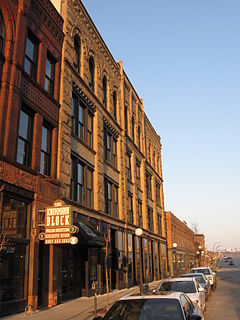
The Fourth Street Historic District is a historic district in Sioux City, Iowa, United States. It consists of a concentration of fifteen late-nineteenth-century commercial buildings between Virginia and Iowa Streets that date from 1889 to approximately 1915. Many of the buildings are significant for their elaborate Romanesque Revival architecture. The area is now a local center of restaurants, bars, and specialty shops.
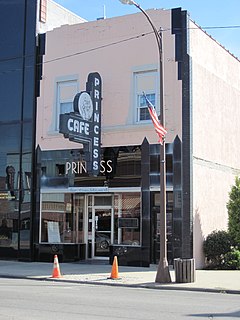
The Princess Sweet Shop is a historic building located in Iowa Falls, Iowa, United States. It is noted as "an outstanding example of Art Deco design from 1935. The Carrara Glass façade, and streamlined woodwork are typical of Art Deco design of the 1920s and 1930s, but a rarity in a small town in Iowa." E.J. Karrys opened the Princess in 1915, and the Sweet Shop opened by H.K. Pergakis two years later. Both Karrys and Pergakis were Greek immigrants, a group who were known to establish candy shop around the U.S. They combined their operations at the Princess location in 1928. The building was destroyed in a fire on December 25, 1934. Local architect L.L. Klippel designed the new building, which was completed in 1935. It was the first building in Iowa Falls that was air conditioned. Members of the Perkagis maintained ownership until 1987. The business is still in operation as a soda fountain under different ownership.

Davenport Bank and Trust Company was for much of the 20th century the leading bank of the Quad Cities metropolitan area and the surrounding region of eastern Iowa and western Illinois. It was at one time Iowa's largest commercial bank, and the headquarters building has dominated the city's skyline since it was constructed in 1927 at the corner of Third and Main Streets in downtown Davenport, Iowa. It was acquired by Norwest Bank of Minneapolis in 1993 and now operates as part of Wells Fargo following a 1998 merger of the two financial institutions. The historic building was listed on the National Register of Historic Places in 1983 under the name of its predecessor financial institution American Commercial and Savings Bank. In 2016 the National Register approved a boundary increase with the Davenport Bank and Trust name. It was included as a contributing property in the Davenport Downtown Commercial Historic District in 2020. It remains the tallest building in the Quad Cities, and is today known as Davenport Bank Apartments as it has been redeveloped into a mixed-use facility housing commercial, office and residential space.

City Market is a historic building located in downtown Davenport, Iowa, United States. It was individually listed on the National Register of Historic Places in 1984. In 2020 it was included as a contributing property in the Davenport Downtown Commercial Historic District.
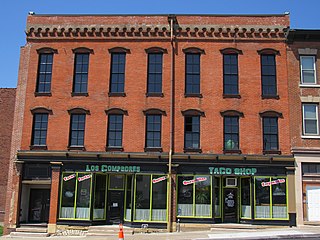
The Wupperman Block/I.O.O.F. Hall is a historic building located just north of downtown Davenport, Iowa, United States. It was individually listed on the National Register of Historic Places in 1983. In 2020 it was included as a contributing property in the Davenport Downtown Commercial Historic District.
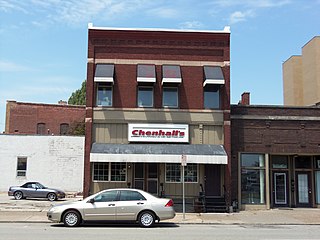
Iowa Reform Building is a historic building located in downtown Davenport, Iowa, United States. It was listed on the National Register of Historic Places in 1983 and on the Davenport Register of Historic Properties in 2002.

The Old City Hall, also known as Oxford Flats, is located just north of downtown along a commercial corridor in Davenport, Iowa, United States. It was individually listed on the National Register of Historic Places in 1983. In 2020 it was included as a contributing property in the Davenport Downtown Commercial Historic District.
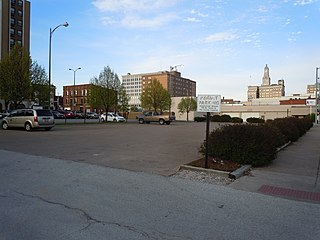
The Hoffman Building was a historic building located in downtown Davenport, Iowa, United States. The building was built around 1855. John V. Hoffman operated a grocery store in the shop on the first floor. He lived in the apartment on the second floor. The building was typical of Davenport's early commercial architecture with a steep-pitched side-gable roof. It featured a well-preserved cast-iron shop front. In its early days a long shed roof extended from the building and was supported by posts along the curb to shelter the sidewalk. It and was listed on the National Register of Historic Places in 1983. Like the Prien Building next door, Mueller Lumber Company across the street and the Riepe Drug Store/G. Ott Block on the 400 block of Second Street, it was torn down in the late 20th century.

The Schick's Express and Transfer Co. was located in downtown Davenport, Iowa, United States. It was listed on the National Register of Historic Places in 1983. The building became part of the Petersen, Harned, von Maur department store complex.
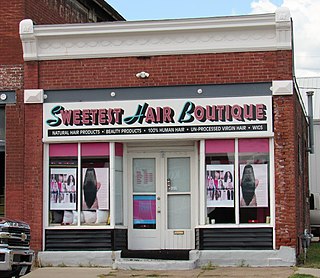
Peters’ Barber Shop is a historic building located in the West End of Davenport, Iowa, United States. It was completed in 1905 and it has been listed on the National Register of Historic Places since 1984.

The Young Brothers Chevrolet Garage is a site on the National Register of Historic Places located in Chinook, Montana. It has also been known as AAA Garage, as Taylor Motor Company, as Tilleman Chevrolet, and as Precision Auto Body. It was added to the Register on August 16, 1994. It is a stucco building with an asphalt roof.

The Old Fourth Ward Southeast Historic District is a nationally recognized historic district located in Waverly, Iowa, United States. It was listed on the National Register of Historic Places in 2013. At the time of its nomination it contained 137 resources, which included 87 contributing buildings, and 50 non-contributing buildings. The historic district is a residential area immediately to the south of the Waverly East Bremer Avenue Commercial Historic District, and within the bend of the Cedar River. The primary resources in the district are all houses, and the secondary resources are either carriage houses or garages. All but four houses contribute to the historical significance of the district, but a majority of the secondary resources do not.

The Morency Paint Shop and Apartment Building is a historic mixed-use building at 77-79 Portland Street on the east side of St. Johnsbury, Vermont. Built in 1890 by a carriage painter, it is a good example of Victorian vernacular mixed commercial and residential architecture. Now completely in residential use, it was listed on the National Register of Historic Places in 1994.

The Red Ball Garage, also known as the Ed Neil Garage, is a historic building located in Swedesburg, Iowa, United States. The building is located along what was known as the Military Road. Because of the marshy land in the area, wagons and buggies had to be pulled out of the mud. In 1913 the road became a part of the Red Ball Route, a highway that linked the Minneapolis/St. Paul area with St. Louis. It received its name from the highway signs used to mark the route. The highway was paved from 1929 to 1930, and later became U.S. Route 218 until it was moved to the east as a four lane-highway in the 1990s.

Franklin Printing House, also known as the Koza Building, is a historic building located in Iowa City, Iowa, United States. It was built in 1856 expressly for the purposes of housing the Iowa Capitol Reporter, a local newspaper named for when this was Iowa's capital city. The newspaper's offices were located on the main floor, the composition room was on the second floor, and printing press was in the basement. The Iowa Capitol Reporter was sold by the 1860s and the Iowa City Republican took over the building. They moved out in the mid-1870s, and the building housed a series of saloons into the 1890s. After it was occupied by a variety of businesses, the building housed John V. Koza's meat shop for about 40 years. The three-story brick building is considered an excellent example of pre-Civil War commercial architecture in Iowa City. The metal cornice across the top of the main facade dates from sometime prior to 1904. The present storefront dates to a 1984 renovation, at which time the two cast iron columns were discovered. The building was listed on the National Register of Historic Places in 1986.

The Cedar Rapids Central Business District Commercial Historic District is a nationally recognized historic district located in Cedar Rapids, Iowa, United States. It was listed on the National Register of Historic Places in 2015. At the time of its nomination it consisted of 60 resources, which included 46 contributing buildings, one contributing structure, 12 non-contributing buildings, and one non-contributing structure. Cedar Rapids was platted on the east bank of the Cedar River as Rapids City in 1841, and it was incorporated under the same name in 1849. Kingston was established on the west bank of the river in 1852. The two smaller communities consolidated in 1870 as Cedar Rapids. The streets were laid out parallel and perpendicular to the river, which flowed from the northwest to the southeast. The Chicago, Iowa and Nebraska Railroad was the first to arrive in the community in 1859 and the tracks were laid on Fourth Street on the eastern edge of the central business district. The first bridge across the river was built at Third Avenue in 1871.
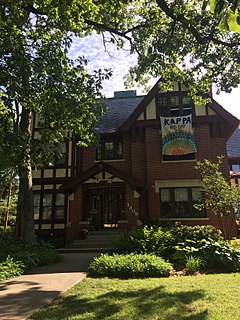
The Minnie Y. and Frank P. Mattes House is a historic building located in Des Moines, Iowa, United States. Its significance is attributed to its association with the prominent Des Moines architectural firm of Proudfoot, Bird & Rawson, and it calls attention to their residential work. The historic designation includes the large scale Tudor Revival house, automobile garage, and the retaining wall and entrance steps that were all constructed in 1910 for the Mattes. Both Frank and Minnie were from prominent Des Moines German-American families. He was a brewer until prohibition in the city, and he was then involved with real estate. The property was sold to Guy M. and Madeline Lambert in 1944, who sold it to the Drake University sorority Kappa Kappa Gamma in 1959. Other houses in the neighborhood were converted in a similar manner.
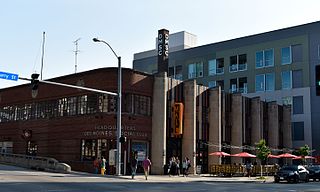
The Des Moines Fire Department Headquarters' Fire Station No. 1 and Shop Building are historic buildings located in downtown Des Moines, Iowa, United States. Completed in 1937, the facility provided a unified campus for the fire department's administration, citywide dispatch, training, maintenance, as well as the increased need for fire protective services in the commercial and warehouse districts in which the complex is located. It was designed by the Des Moines architectural firm of Proudfoot, Rawson, Brooks and Borg, and built by local contractor F.B. Dickinson & Co. The project provided jobs for local residents during the Great Depression, and 45% of its funding was provided by the Public Works Administration (PWA). The City of Des Moines provided the rest of the funds. The radio tower, which shares the historic designation with the building, was used to dispatch fire personnel from 1958 to 1978. The buildings were used by the local fire department from 1937 to 2013. It was replaced by two different facilities. The old fire station and shop building was acquired by the Des Moines Social Club, a nonprofit arts organization.

The Davenport Motor Row and Industrial Historic District is a nationally recognized historic district located on the eastern edge of downtown Davenport, Iowa, United States. It was listed on the National Register of Historic Places in 2019. At the time of its nomination it consisted of 28 resources, which included 21 contributing buildings, one contributing site, one contributing structure, and five non-contributing buildings. The area was previously a part of the notorious Bucktown, a district of saloons, beer gardens, brothels, billiard parlors, gambling establishments, and theaters. Davenport licensed prostitution in 1893, gambling in 1904, and failed to enforce Iowa prohibition laws during this period. A crusade against vice by Davenport's Catholic bishop, Henry Cosgrove, and reforms by state leaders led to the district's transformation in the early 20th century into a light industrial area. The city's automobile industry settled here beginning in the 1910s. They stayed until the mid-20th century when Interstate 80 was completed on the north side of the city and they moved to the suburban areas. U.S. Route 32 and its successor U.S. Route 6 passed through the district on East Second Street from 1926 to 1937. The Government Bridge (1896), which for years was the city's only bridge across the Mississippi River, is immediately adjacent to the district.






















